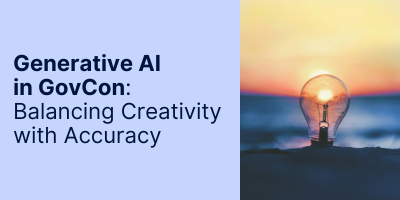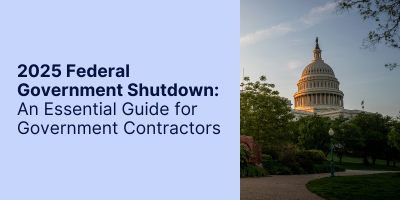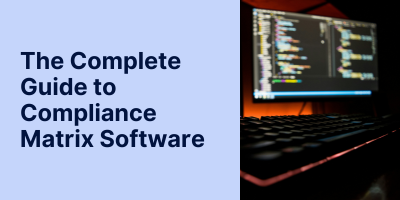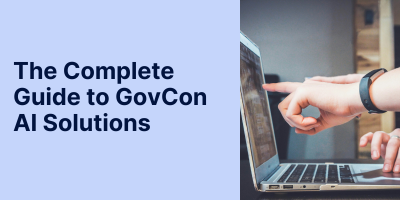Generative AI in GovCon: Balancing Creativity with Accuracy
Generative AI tools can unlock new levels of productivity and creativity in government contracting, but they also carry risks of “hallucinations” - plausible-sounding but incorrect output. The debate has heated up: some AI vendors have dialed back their models so much that users often get bland “I can’t find any information on that” responses.
Yet over-caution can snuff out AI’s creative spark. Experts now argue for a balanced approach: allow AI to be inventive, but require verifiable sources and human review. In the GovCon world, thought leaders like Procurement Sciences advocate exactly this: use AI to drive innovation, while keeping a person in the loop to fact-check and polish AI-generated content. As one Procurement Sciences executive analogized, an unchecked AI is like “an unreliable narrator” – it might tell a captivating story, but it could also fabricate facts.
This post explores why hallucinations are both the danger and the promise of generative AI, how government and industry best practices are evolving, and why Procurement Sciences is at the forefront of responsible AI in government contracting.
The Hallucination vs. Creativity Conundrum
AI “hallucinations” happen when large language models produce false or misleading information with confidence. In critical contexts like proposals or compliance, such errors can have big consequences – from misleading a contract officer to risking legal liability. Indeed, blindly trusting AI content cannot be done, especially for critical (high-risk) applications, and human oversight is still essential. In the GovCon space, experts warn that any inaccurate claim in a proposal – whether written by a person or AI – can lead to lost bids, bid protests or even legal exposure. Accordingly, government guidance and industry counsel stress that contractors remain responsible for every word: AI does not absolve a contractor of responsibility for the accuracy of the content of a proposal.
Yet hallucination is a double-edged sword. The same algorithms that can spin out falsehoods also enable unprecedented creativity and novel ideas. For example, AI might suggest innovative solutions or win themes that a team hadn’t considered. Hallucinations can have an innovative upside: they can spur imaginative leaps in design, strategy, or marketing that a purely logical process might miss. In creative fields like art and data visualization, AI’s hallucinatory capabilities have been used to generate stunning, dreamlike imagery and to reveal fresh insights.
The challenge is finding the sweet spot. If we completely suppress AI’s creativity (for instance by forcing it to always say “I don’t know” when uncertain), we lose much of the value. But if we let AI “go wild,” we risk fabricating critical mistakes. The emerging consensus is a middle path: ground AI in facts and keep humans in the loop. In practice, this means using techniques like Retrieval-Augmented Generation (RAG) – linking the AI to verified documents and databases – and then having subject-matter experts vet the draft. In short: encourage AI’s creativity, but always cite and verify.
Government & Industry Best Practices
Across government and GovCon industry, the playbook is converging on responsible AI usage. Major agencies have begun issuing guidance emphasizing human-in-the-loop oversight, transparency, and data grounding. In practice, this means prompting the AI with external information from trusted sources so that its answers are anchored in factual context.
Similarly, new public-sector AI guidelines call on agencies to ensure high-quality inputs and robust review. They explicitly advise checking every result against trusted sources and even programming AI to say “I do not know” when uncertain. Procurement Sciences echoes this: their blogs stress that providing AI with the right documents (RFPs, past proposals, style guides, etc.) improves precision and accuracy, enabling factually correct and reliable responses. This approach is essentially Retrieval-Augmented Generation (RAG): the AI’s “hallucination” is tamed by a library of validated data.
Government contractors themselves are heeding these lessons. Legal experts advise firms to double-check every AI-generated statement in a proposal and maintain audit trails of AI usage. The Defense Acquisition University’s guide warns of “confabulation” and explicitly instructs contracting professionals to validate AI-generated information and maintain human oversight to prevent reliance on inaccurate data.
Best practices include:
- Human-in-the-loop review: Always have qualified staff review AI outputs before they are submitted. As Procurement Sciences puts it, humans must “put the finishing touches on content” that the AI drafts.
- Grounding and citations: Feed the model accurate, domain-specific data (RFPs, regs, past answers) so it can provide responses that are not only accurate but also contextually relevant. Document sources of any factual claims.
- Audit trails and transparency: Record how AI was used: save prompts, versions, and edits. This helps ensure compliance and allows reconstruction if an issue arises.
- Training and governance: Develop clear policies: know what data the AI can access, restrict proprietary or classified input, and certify that any AI tools meet FedRAMP/SOC2 standards. Educate teams on AI’s limits and ethical use.
These practices are not optional in GovCon – they align with evolving regulations and acquisition rules. Errors in AI-generated proposals can trigger bid protests or even liability. In short, while AI is embraced, its use must be accompanied by rigorous oversight at every step.
AI in Action: Case Studies and Use Cases
When deployed wisely, generative AI is already transforming GovCon workflows. Procurement Sciences itself provides concrete examples. In one case study, a mid-sized government contractor used the Awarded.AI platform to tackle two urgent RFPs under tight deadlines. By harnessing AI to analyze requirements and draft proposal sections, the team saved countless hours, produced tailored, high-impact proposals, and ultimately won two significant contracts.
Testimonials on Procurement Sciences’ site even boast 100% win rates: “Every bid we have used the AI on, we have won thus far.” Whether automating compliance matrices, scoring resumes, or generating first-draft narratives, these AI tools helped GovCons focus on strategy rather than boilerplate writing.
Beyond Procurement Sciences’ own clients, the GovCon community is rapidly adopting AI innovations. In surveys, over half of contractors report using AI in business development, capture, or proposal activities by 2025. The use cases include opportunity search (AI flagging new RFPs aligned to a firm’s strengths), proposal red-team reviews (AI acting as a mock evaluator), and automated editing for consistency.
Notably, Procurement Sciences’ Awarded.AI platform was built for GovCon from the ground up, incorporating domain expertise so that it speaks the language of capture managers, proposal writers, and contracting officers. This domain focus yields real ROI: customers report slashing proposal prep time from dozens of hours to under 20 hours, enabling teams to bid on far more opportunities without growing headcount.
Procurement Sciences: Leading Responsible AI in GovCon
Procurement Sciences positions itself as a thought leader in this space. Its founders and team come from GovCon backgrounds (EDS, HP, HPe, DXC, GDIT, Peraton, Idemia, SAIC etc.) and understand the industry’s needs. The company has invested heavily in making AI both powerful and safe: for example, Awarded.AI supports secure context-injection (letting clients upload RFPs, past proposals, style guides, etc.) so that generated drafts are precise and on-brand.
Procurement Sciences’ own “unreliable narrator” analogy underscores their philosophy: AI can generate drafts and insights, but humans must review and refine the final output. Their commitment is backed by credentials. In 2025 they have hired a tremendous amount of new talent in engineering, signaling a focus on advanced generative models. They also launched an AI Certification program for GovCon professionals, explicitly teaching “Safe Use of AI Systems” and compliance best practices.
Indeed, Procurement Sciences brags that Awarded.AI defies the industry norm of failed AI pilots – boasting 90%+ user adoption among customers. In short, Procurement Sciences combines cutting-edge AI engineering with intense customer support, fitting best practices from research and government guidance into its platform. Their approach reflects the consensus: use AI to innovate, but always with an informed human at the helm.
Conclusion
Generative AI is reshaping government contracting, but not without pitfalls. The industry’s consensus is clear: we must embrace AI’s creativity while rigorously guarding against errors. Hallucinations need not be the “devil” if they are managed properly – in fact, a little imaginative AI can spark breakthrough ideas. The key is leveraging AI with trusted data, clear policies, and expert review.
For most GovCon firms today, this means staying in the human-in-the-loop phase: using AI as a co-writer and analyst, not a lone author. Procurement Sciences exemplifies this philosophy. Their Awarded.AI platform is built for the government contracting workflow, and they actively guide customers to pair AI suggestions with manual vetting. With deep domain expertise and high adoption rates, they are at the forefront of realizing AI’s promise in GovCon.
As government guidelines evolve and creative AI tools advance, the most successful contractors will be those who innovate boldly – but do so responsibly, citing every fact and carefully reviewing every section before it goes out under their company’s name.


%20(1)%20(1).png?width=1440&height=711&name=PSciAI-Save-time.-Deliver-faster.-Win-More-(Black)%20(1)%20(1).png)




%20(1200%20x%20600%20px).png)





-2.png)
-2.png)



